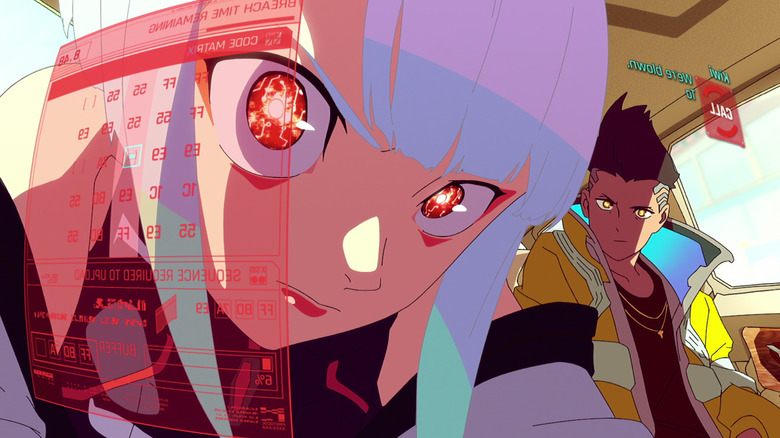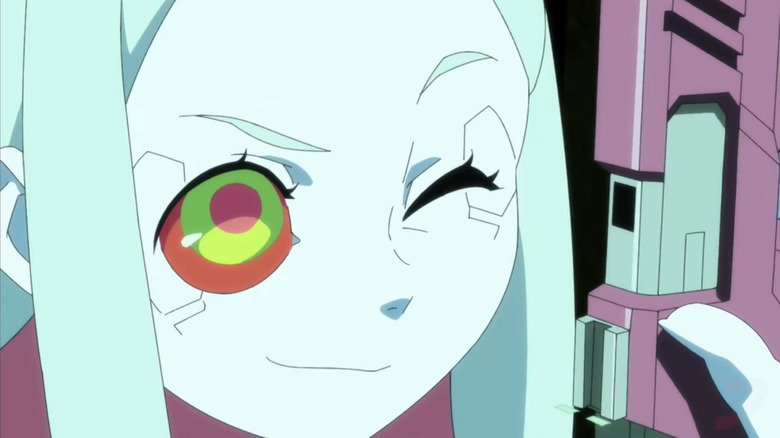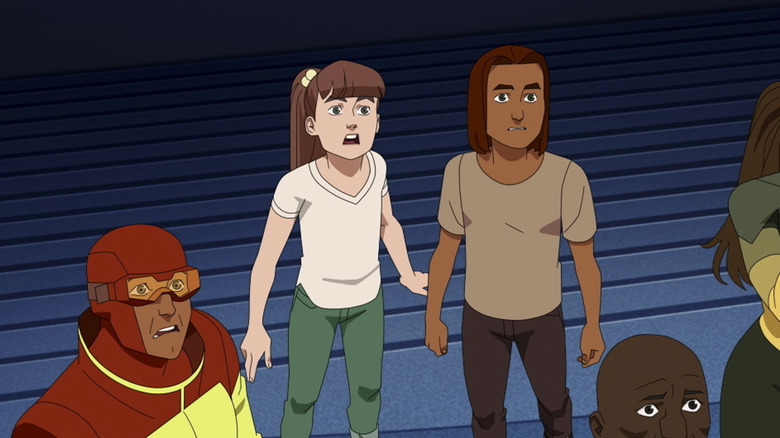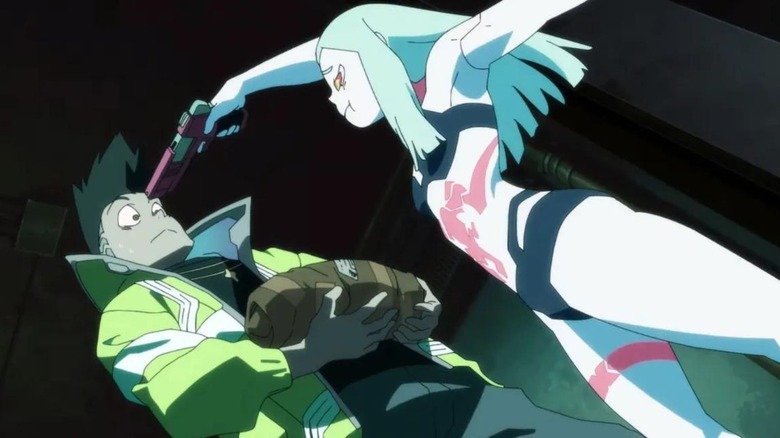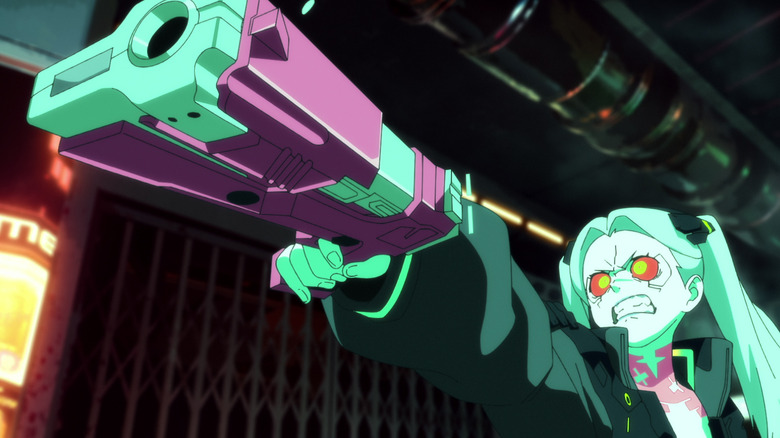The Cyberpunk: Edgerunners Character Who Created Controversy Between The Creators
The "Cyberpunk" brand is no stranger to controversy. After dropping the game "Cyberpunk 2077" at the end of 2020 — itself mired in allegations of sexism and transphobia even before its release — developer CD Projekt Red became the target of scrutiny and criticism after the game failed to operate as promised. To its credit, the studio acknowledged fault, issued refunds, and spent time repairing the mechanics of the game, as well as the goodwill of its customer base.
This work seems to have paid off. With the release of Netflix's wildly popular anime series "Cyberpunk: Edgerunners," the game's sales shot through the roof — and luckily for both new fans and the studio, the game is mostly free of the bugs that once plagued it. A senior developer of the game rejoiced (via Reddit): "its f****** good to be back."
Indeed, "Edgerunners'" superb writing, art, and action have made it a hit among not only video game fans but mainstream anime and television fans as well. To viewers, it's not just a great "video game show" — it's a great show, period. Even in this triumph, however, controversy once again reared its head for the studio after an interview revealed internal conflict over one of its most controversial design choices.
Creating Rebecca
In a recent interview accessed via animesenpai.net and ComicBook.com, a CD Projekt Red team member discussed an aspect of "Cyberpunk" hero Rebecca's character creation. Upon receiving the original character concept artwork, the team member relates that they didn't feel Rebecca fit with Night City's visual or tonal aesthetic because she was a "loli." "They were like 'She's a loli.'" she told the interviewer. "'Lolis don't exist in Night City. It doesn't fit the Cyberpunk 2077 aesthetic'. But Trigger was like 'No, the loli must stay.'" Studio Trigger is the massively popular Japanese animation studio behind "Kill la Kill," two episodes of "Star Wars: Visions," and "Cyberpunk: Edgerunners."
The term "loli" — derived from Vladamir Nobokov's unsettling novel "Lolita" — is a term used to describe female anime characters who are drawn to look prepubescent or otherwise underage despite being written as adults (the term can also be used to refer to minor female characters in anime). This disconnect between appearance and identity has been widely talked about and mocked online, and the representation of this concept can range from passably inoffensive or contextually justified to outright disturbing.
A range of depictions
A recent popular and arguably subdued example of a loli-type character from Western animation is Amanda (aka Monster Girl) from Amazon Prime Video's superhero drama "Invincible." In the series, Amanda's powers gradually stall and reduce her natural aging process, giving this woman in her 30s the appearance of a young child. Amanda's condition is treated in a realistically distressing way — her character experiences crippling insecurities, social isolation, and an existential fear of her powers as a consequence. Though it may be bit strange, it's far from sexualized (it's also worth noting that she dresses in a plain t-shirt and khakis, whereas most loli-type characters are dressed in revealing attire).
In an op-ed discussing the interview and Rebecca's loli design for The Gamer, Jade King presents a view from the other side of the spectrum: "Otherwise stellar characters are ruined by the fact they look like a small child but are actually a 9,000-year-old dragon or come from another planet or some other nonsense explanation, meaning the show feels it's okay for them to be sexualized in every other scene, even if they live a childlike life with activities such as primary school. It's really gross." In their analysis, the supernatural backstory of a character is normally just an excuse to sexualize a minor.
Criticism of the interview and Rebecca herself
Popular online political commentator and self-professed "Cyberpunk" fan Hasan Piker provided his point of view on the issue during a Twitch broadcast, stating that he views lolis as a whole very negatively. "I am not a fan [of loli]," he said. "I am not fond of it. I think it's bad, I think it's gross." Shortly after this statement, he lightly likened fans of lolis to pedophiles, a common comparison made in online circles. After hearing Studio Trigger's now infamous response to CDPR's concerns, Piker said, "Yeah, that makes sense that they did that ... they were riding for the f****** loli, which is weird as f***, man." One of his chatters categorized the loli as a consequence of fan service.
The Gamer's Jade King addresses this aspect of creating lolis (and other archetypes) in anime for fans as well: "Their presence is all but required, both to draw in audiences who gravitate towards these characters and increase the potential swathes of merchandise that stand a chance at surfacing upon mining success." She went on to criticize lolis specifically, saying, "I can think of countless examples from great shows that are dragged down because they are for some reason committed to providing this gross bit of fanservice."
Even from her first entrance, Rebecca is disturbingly and blatantly sexualized. "Her opening scene involves answering a door wearing nothing but her underwear," King writes, later saying, "We are expected to examine her figure before we know anything about her, taking in her small height, flat chest, and immature figure at face value like it is something to be admired."
Do fans like Rebecca?
Her controversial appearance aside, Rebecca has become a stand out on the show. Though some may argue this is at least due in part to her sexualization, others feel she's merely written in a genuinely compelling and engaging way. Comic Book Resources' Britny Murray feels that viewers resonated with Rebecca's dedication to her mission, writing, "Rebecca's popularity was solidified when she committed to being there for David and his cause in a way that other characters were unable to be. ... She continued to look out for his welfare up until her tragic end."
Even The Gamer's Jade King can understand why Trigger Studios wanted to keep the character and why she connects with fans, saying, "I'm not surprised at all [Trigger] fought back, and Rebecca is easily one of the show's best characters." In his Twitch commentary, Hasan Piker expressed that the problem was simply her design, rhetorically advising the studio, "You could've just literally avoided this by drawing them as, like, a normal adult." King's sentiment resembles Piker's, though she also alleges "her [Rebecca's] design remaining untouched has resulted in rotten corners of the internet deciding that suddenly having permission to be sexually attracted to a character designed to look underaged is a cause for celebration."
If King's assessment is true, it certainly colors CDPR's interview and Trigger Studio's actions in a more uncomfortable light. According to animesenpai.net, the team member interviewed went on to say that, though she had originally voted against Rebecca's inclusion, her opinion has since reversed — she now considers the character "the best girl" of "Cyberpunk: Edgerunners." Though this is likely due to Rebecca's popularity and characterization, it may still be troubling to some that such a popular character perpetuates an arguably creepy anime trope.
